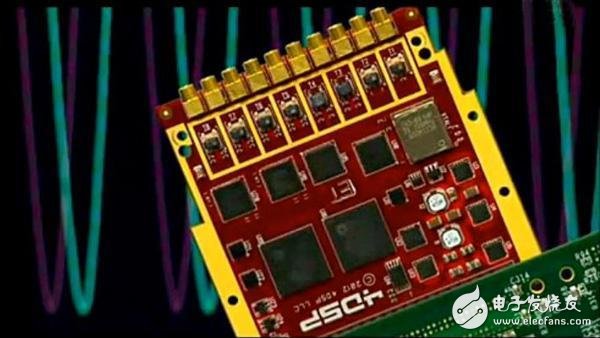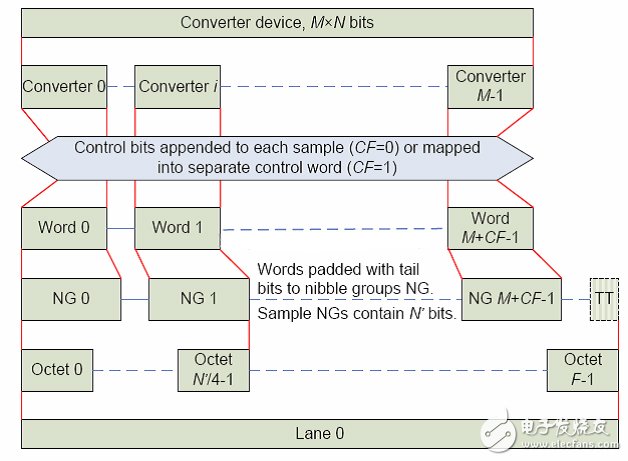The main function of the data transmission layer maps the data sampled by the AD converter into byte data of 8 bits wide, and is divided into 4 cases according to the application: A single conversion unit in an AD converter corresponds to a data transmission channel Multiple conversion units in one AD converter correspond to one data transmission channel A single conversion unit within an AD converter corresponds to multiple data transmission channels Multiple conversion units in one AD converter correspond to multiple data transmission channels The system may have multiple AD conversions connected in one transmission system at the same time, but it is relatively independent for the mapping of its internal data, and the mapping inside each AD converter is consistent with the manner described in the above 4. The data result converted by each AD converter is mapped into a F-byte data frame. In many applications, the clock frequency of the frame clock will be consistent with the clock frequency of the sample clock, but at the same time JESD204 allows the AD converter to work. In the oversampling state, S represents the coefficient of the over-sampling of the AD converter, and S must be an integer. If S is 2, it means that the AD operates at twice the oversampling frequency. In this case, the AD sample is 2 The secondary data will be mapped to the same frame. Set the data precision of each AD conversion to N. For example, if the 14-bit conversion precision is AD, the value of N will be set to 14. In order to more accurately represent the transmission result, some additional information is added, called the control bit. The specific meaning of the control bit is determined by the system designer. For example, the control bit can indicate whether the conversion is normal. In addition to the control bit, there is also a type called tail bit, which mainly performs two functions: First, when the converted data cannot be integrated into an integer data frame, the tail bit is used as a supplement. For example, if the precision of the converter is 13 bits and the control bit length is 1 bit, 14-bit data is mapped to a 2-byte data frame. There will be a 2bit margin, which will be supplemented with tailbit. Second, the tail bit can control the overall polarity of the data frame according to the number of 0 and 1 in the data, so as to maintain the DC balance of the data frame, that is, the number of 0 and 1 in the data frame can be maintained. Consistent. According to the topology of the system data transmission described above, the data mapping can be divided into the following forms. In this mode, the data of one or more data conversion units in the AD converter will be mapped into a data data channel. The specific mapping rules are described below. 1.1.1 Data Mapping for Normal Sampling This section describes how data is mapped by AD without oversampling. An AD converter can contain M data conversion units, which means that the AD ball selector can contain M data conversion channels. As shown in FIG. 10, all the data in the figure are counted from 0, wherein MSB represents data. The highest bit, LSB indicates the lowest bit of the data, the specific data mapping rules are as follows: The sampled data will be linearly mapped from the order of data sampling unit 0 and unit 1. The result of data sampling will be mapped to word first, that is, the bit width of 16 bits. When the sampled data has no control bit, the sampled data will be directly expanded to 16 bits. When the sampler has a valid control bit, the mapping is divided into two types. Happening: 1. The control bit mapping of each sampled data corresponds to the lowest bit of the sampled data. 2. The sampled data is directly mapped to a 16-bit word, and all control bits are individually mapped into one control word. The first bit of the controlled word corresponds to the control bit of the conversion unit converter0, and so on. CF indicates the number of controlwords in the data frame. In the case of a single transmission channel, the value of CF can be 0 or 1, and the number of words in the data frame will be expressed as: M+CF. When the number of bits in a word is not a multiple of 4, it is supplemented by the tail bit. The supplementary data is shown in Figure 10. It is called "NG". Of course, this step requires good transmission efficiency in the system. It can also be skipped in case. In a conversion word, N' represents the length of the valid data in the word, and N' is a multiple of 4, that is, N' can be 4, 8, 12, 16. When the value of N' is greater than N, the value greater than the part is supplemented by the control bit or the tail bit. note: When CF=0, that is to say, when controlbit and sample data are combined in the same word, the tail bit does not appear in the middle of the sample data and control bit, but can be connected behind the control bit, that is, the word is mapped. The order is sample data, control bit, and tail bit. When CF=1, the sample data and control bit will be in different data. In this case, when the sample data is mapped, it can be directly connected to the tail bit. The Tail bit must ensure that the length of the data frame is a multiple of 8 bits after the mapping, that is, the guaranteed frame length is an integer number of bytes. The above mapped data frames will be decomposed into F octets for transmission to the data link layer. Figure 10: Mapping of normal sampled data
Outdoor Led Display screens for rental-- Die casting cabinet
LED technology is the latest and the best in terms of the audio visual technologies out there and it is still evolving. There is a strong emphasis in making LED display screens energy efficient, cost efficient and light weight apart from other quality requirements. Hence,Stage LED screen cabinets are also now expected to be lighter in weight. This need has resulted into the gradual shift from the iron cabinet, aluminum cabinet, to the cast-aluminum and die cast aluminum as the weight of the cabinet is lighter. Cast aluminum and die cast-aluminum cabinets are the latest of the cabinets used for LED casing.
The cast aluminum and die cast-aluminum cabinets have high strength and high tenacity. They are highly efficient, provide excellent heat dissipation, energy conservation and environmental protection. Because of their outdoor usage, Rentel led display cabinet is made as a waterproof cabinet of leasing cast aluminum. They are lightweight and ultrathin. They are quite flexible for easy packaging and lifting. They have a high refresh rate, high grayscale and are widely applied to the stage renting. They are easy and simple to install and thus help you save on precious time and man power as one-person can easily do the insallation. Cabinet splicing and wiring connection is fast and reliable. Not only great in looks dept. it can be easily dismantled. Casting Aluminum and die Casting Aluminum Cabinet also have better deformation resistance property.
Rental Led Display, Rental Led screen,Stage Led Screen, Led Display screen Shenzhen Priva Tech Co., Ltd. , https://www.privaled.com

Several data mapping forms under the topology of system data transmission
1 data transmission layer